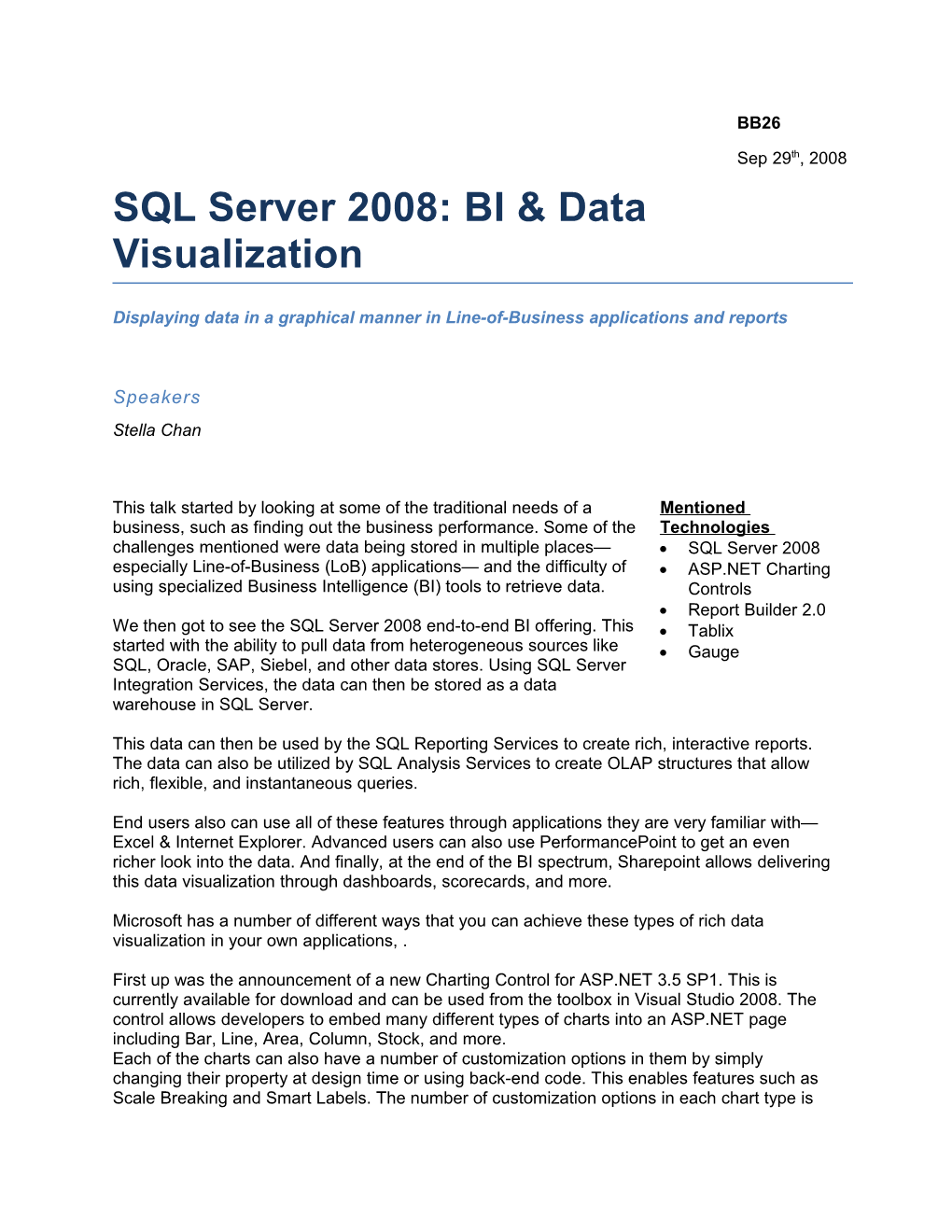Sep 29th, 2008
SQL Server 2008: BI & Data Visualization
Displaying data in a graphical manner in Line-of-Business applications and reports
Speakers
Stella ChanThis talk started by looking at some of the traditional needs of a business, such as finding out the business performance. Some of the challenges mentioned were data being stored in multiple places—especially Line-of-Business (LoB) applications— and the difficulty of using specialized Business Intelligence (BI) tools to retrieve data.
We then got to see the SQL Server 2008 end-to-end BI offering. This started with the ability to pull data from heterogeneous sources like SQL, Oracle, SAP, Siebel, and other data stores. Using SQL Server Integration Services, the data can then be stored as a data warehouse in SQL Server. / Mentioned Technologies
- SQL Server 2008
- ASP.NET Charting Controls
- Report Builder 2.0
- Tablix
- Gauge
This data can then be used by the SQL Reporting Services to create rich, interactive reports. The data can also be utilized by SQL Analysis Services to create OLAP structures that allow rich, flexible, and instantaneous queries.
End users also can use all of these features through applications they are very familiar with—Excel & Internet Explorer. Advanced users can also use PerformancePoint to get an even richer look into the data. And finally, at the end of the BI spectrum, Sharepoint allows delivering this data visualization through dashboards, scorecards, and more.
Microsoft has a number of different ways that you can achieve these types of rich data visualization in your own applications, .
First up was the announcement of a new Charting Control for ASP.NET 3.5 SP1. This is currently available for download and can be used from the toolbox in Visual Studio 2008. The control allows developers to embed many different types of charts into an ASP.NET page including Bar, Line, Area, Column, Stock, and more.
Each of the charts can also have a number of customization options in them by simply changing their property at design time or using back-end code. This enables features such as Scale Breaking and Smart Labels. The number of customization options in each chart type is numerous and can be tailored to suit your need.
Next up came the usage of the Report Control for VS2005/2008. We took a look at the new Tablix control in Reporting Services that combines the Table (fixed columns, dynamic rows) and Matrix (dynamic rows, dynamic columns). We also got to see a look at the new Chart and Gauge controls in Reporting Services.
Stella then talked about what’s coming up in the next version of the Report Viewer control. The new Rs2008 rendering engine, AJAX support, programmability improvements, and richer visualization in both Web and Windows LoB applications, were just some of the more important new features. A set of screenshots of this new control rounded out the session.
List of demos
ASP.NET Chart control / Creating and working with Charts in an ASP.NET page in VS2008 / About 10 min into the sessionBinding data to a Data model / Connecting a Chart control to a Data model to display it graphically / About 20 min into the session
Authoring and embedding a Report / Creating a new report in SSRS and embedding it in a LoB application / About 35 min into the session
Conclusion
“A picture is worth a thousand words” is a saying that holds true when working with data too. Displaying large amounts of data in a graphical format allows end users to understand and work with this data in a more meaningful manner. SQL Server 2008 and Visual Studio 2008 allow you to add rich data visualization into your apps quickly.SQL Server 2008 is an end-to-end BI platform. You can use the features it offers which use some of the new technologies that are available. The ASP.NET 3.5 Chart Control allows you to add charts of different types into your Web-based application. You can use the upcoming Report Viewer to add even richer and much more interactive reports from SSRS into Windows and Web apps.
Vinod Unny
